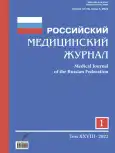Assessment of the comparative efficiency of treatment with angiotensin-converting enzyme inhibitor and angiotensin II receptor blockers in patients who are old and senile with stage 3, grade 2–3 hypertension
- Authors: Zaslavskaya R.M.1, Krivchikova L.V.2, Teyblyum M.M.3
-
Affiliations:
- Space Research Institute of RAS
- Loginov Moscow Clinical Research Center
- Sogas-Med Insurance Company
- Issue: Vol 28, No 1 (2022)
- Pages: 57-63
- Section: Clinical medicine
- URL: https://journals.rcsi.science/0869-2106/article/view/108902
- DOI: https://doi.org/10.17816/medjrf108902
- ID: 108902
Cite item
Abstract
BACKGROUND: The problem of sex differences in the treatment of hypertension is currently relevant because of the different disease course in men and women. Particular attention should be paid to the age aspect of the problem, since the clinical and hemodynamic parameters of arterial hypertension (AH) in patients who are old and senile have their specifics.
AIM: This study aimed to assess the sex aspect of the comparative efficiency of the angiotensin-converting enzyme inhibitor (ACEI) perindopril and angiotensin II receptor blockers (ARB) losap, losartan, and lorista patients who are old and senile with stage 3, grade 2–3 hypertension.
MATERIALS AND METHODS: A total of 185 patients with stage 3, grade 2–3 hypertension were examined. Two randomized groups of patients were formed depending on the therapy received. Group 1 received ACEI (perindopril), and group 2 patients received ARBs (lozap, losartan, and lorista). Patients kept a diary in which the amount and types of pain, dizziness, and heart palpitations were noted. In addition, the Health, Activity, and Mood Questionnaire and daily self-monitoring of blood pressure every 3 h during the hospital stay and for 2–3 months after discharge were used. The obtained information was processed using variation statistics and the difference method.
RESULTS: The analysis of the comparative efficiency of ARBs and ACEIs revealed significant sex differences in hemodynamic parameters. The ARB group of drugs showed a more pronounced decrease in 24-h blood pressure monitoring (24-h BPM) and the number of pain episodes in the heart area in women compared with men. When using ACEI, no sex difference in the decrease in 24-h BPM indicators was observed. However, significant differences in clinical symptoms of both men and women were found. In women, compared with men, ACEIs had a greater positive effect on the subjective state in points (according to the Health, Activity, and Mood Questionnaire).
CONCLUSIONS: The results suggest that ARB therapy for women who are old and senile with stage 3, grade 2–3 hypertension. For men of a similar age with this pathology, therapy with both ACEIs and ARBs may be recommended.
Full Text
##article.viewOnOriginalSite##About the authors
Rina M. Zaslavskaya
Space Research Institute of RAS
Author for correspondence.
Email: rinazaslsvskaya@mail.ru
ORCID iD: 0000-0002-3476-7774
MD, Dr. Sci. (Med.)
Russian Federation, MoscowLarisa V. Krivchikova
Loginov Moscow Clinical Research Center
Email: lkrivchikova@bk.ru
ORCID iD: 0000-0003-3021-9532
MD, Cand. Sci. (Med.)
Russian Federation, MoscowMichail M. Teyblyum
Sogas-Med Insurance Company
Email: misha@tejblum.pp.ru
ORCID iD: 0000-0001-5870-5079
MD, Dr. Sci. (Biol.)
Russian Federation, MoscowReferences
- Lazebnik LB, Shutemova EA, Komissarenko IA, et al. Twenty-four-hour blood pressure profile in elderly patients with borderline arterial hypertension. Russian Journal of Cardiology. 2004;9(3):10–13. (In Russ).
- Shalnova SL, Martsevich SY, Deev AD, et al. PROLOG Study: decreasing cardiovascular disease risk in hypertensive patients by antihypertensive therapy. Kardiovaskulyarnaya terapiya i profilaktika. 2005;4(4):10–15. (In Russ).
- Ostroumova OD. Perindopril v doze 8 mg v kachestve startovogo lecheniya bol'nykh arterialnoi gipertoniey v usloviyakh statsionara. Biomeditsina. 2006;1(5):33–34. (In Russ).
- Glezer MG. Gender characteristics of the course and treatment of hypertension in the elderly. Clinical Gerontology. 2012;18(5–6):3–10. (In Russ).
- Zaslavskaya RM, Krivchikova LV. Gender-related differences in the efficacy of treatment of hypertensive and coronary heart diseases in aged and elderly patients by angiotensin II receptor blockers and angiotensin converting enzyme inhibitors. Clinical Medicine. 2013;91(10):67–68. (In Russ).
- Zaslavskaya RM, Shcherban’ EA, Krivchikova LV, et al. Sovremennye podkhody k otsenke effektivnosti lecheniya serdechno-sosudistykh zabolevaniyakh i vliyanie faktorov zemnoi i kosmicheskoi pogody. Moscow: Medpraktika-M; 2016.
Supplementary files















